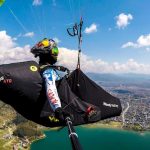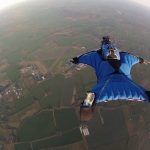Download links
How to install Soaring Through the Sky: The Thrill of Wingsuit Flying APK?
1. Tap the downloaded Soaring Through the Sky: The Thrill of Wingsuit Flying APK file.
2. Touch install.
3. Follow the steps on the screen.
Description
Wingsuit flying, a breathtaking blend of human ingenuity and the primal urge to soar, has a rich history that dates back to the early 20th century. The concept of gliding through the air with a suit designed to enhance lift can be traced back to the pioneering work of early aviators and inventors. One of the first recorded instances of a wingsuit-like apparatus was in 1912 when a Frenchman named Franz Reichelt attempted to fly from the Eiffel Tower using a parachute suit he designed.
Although his tragic attempt ended in failure, it laid the groundwork for future innovations in human flight. The modern wingsuit, however, began to take shape in the late 1990s, thanks to the efforts of skydivers who sought to extend their freefall experience. The first wingsuits were rudimentary, often resembling a simple jumpsuit with fabric wings attached between the arms and legs.
These early designs allowed for limited horizontal movement and were primarily used by experienced skydivers looking to add an extra dimension to their jumps.
By the early 2000s, wingsuit flying had gained popularity as a distinct sport, attracting thrill-seekers and adventurers eager to experience the sensation of flying.
Key Takeaways
- Wingsuit flying has a history dating back to the early 20th century, with pioneers like Clem Sohn and Rex Finney making significant contributions to the sport.
- The physics of wingsuit flying involve aerodynamics, lift, and drag, which enable the flyer to achieve forward motion and control their descent.
- Training and preparation for wingsuit flying are crucial, involving extensive practice, physical fitness, and knowledge of emergency procedures.
- Risks of wingsuit flying include collisions, equipment malfunctions, and weather conditions, but safety measures such as proper gear and thorough pre-flight checks can mitigate these dangers.
- The thrill of wingsuit flying lies in the exhilarating sensation of soaring through the air and experiencing a unique perspective of the world from above.
The Physics of Wingsuit Flying
The Role of Lift and Drag
When a wingsuit pilot jumps from an aircraft, they enter freefall, and their body begins to interact with the surrounding air. The wingsuit’s design creates a larger surface area, allowing the pilot to generate lift as they descend. This lift counteracts gravity, enabling the pilot to glide horizontally rather than plummeting straight down.
Mastering the Angle of Attack
The angle of attack is a critical factor in wingsuit flying. By adjusting their body position and the angle at which they enter the airflow, pilots can manipulate lift and drag to achieve varying flight paths. A higher angle of attack increases lift but also increases drag, which can slow down the descent rate. Conversely, a lower angle of attack reduces lift but allows for faster speeds.
The Delicate Balance of Wingsuit Flying
This delicate balance is what makes wingsuit flying both exhilarating and complex; pilots must constantly adjust their body position to maintain control and optimize their flight path. By understanding the physics behind wingsuit flying, pilots can refine their skills and experience the thrill of flying through the air with precision and control.
The Training and Preparation for Wingsuit Flying

Training for wingsuit flying is a rigorous process that requires dedication, skill, and a solid foundation in skydiving. Before even considering a wingsuit jump, aspiring pilots must complete a minimum number of skydives—typically around 100 jumps—while honing their skills in freefall and parachuting techniques. This foundational training is crucial, as it helps develop an understanding of body control in freefall, which is essential for successful wingsuit flying.
Once a skydiver has achieved the necessary experience, they can begin specialized wingsuit training. This often involves ground school sessions where instructors cover the intricacies of wingsuit design, aerodynamics, and emergency procedures. Following this theoretical training, students typically engage in practice jumps using smaller wingsuits or even training devices that simulate wingsuit flight.
These initial jumps focus on mastering body positioning and control before progressing to larger suits that allow for more advanced maneuvers. Throughout this training process, safety remains paramount; instructors emphasize the importance of understanding one’s limits and recognizing when conditions are not suitable for wingsuit flying. Source: USPA – Wingsuit Flying
The Risks and Safety Measures of Wingsuit Flying
| Category | Risks | Safety Measures |
|---|---|---|
| Equipment | Equipment failure, such as parachute malfunction | Regular equipment checks, proper training in equipment use |
| Weather | Unpredictable weather conditions | Checking weather forecasts, avoiding flying in adverse conditions |
| Physical Health | Physical strain on the body, potential for injury | Regular physical training, proper warm-up and stretching |
| Experience | Lack of experience leading to errors in judgment | Extensive training, mentorship from experienced wingsuit flyers |
While wingsuit flying offers an unparalleled thrill, it is not without its risks. The combination of high speeds, complex maneuvers, and proximity to terrain can lead to dangerous situations if not approached with caution. One of the most significant risks is the potential for collisions with obstacles such as trees, cliffs, or buildings during flight.
Pilots must possess acute situational awareness and be able to navigate their surroundings effectively to avoid these hazards. To mitigate these risks, safety measures are crucial in wingsuit flying. Experienced pilots often conduct thorough pre-jump briefings that include discussions about weather conditions, potential landing zones, and emergency procedures.
Additionally, many wingsuit pilots utilize advanced technology such as altimeters and GPS devices to monitor their altitude and track their flight paths. These tools provide critical information that can help pilots make informed decisions during their jumps. Furthermore, joining established wingsuit communities or clubs can provide valuable resources for training and safety tips from seasoned professionals who understand the nuances of the sport.
The Thrill of Wingsuit Flying: Experiencing the Rush
The thrill of wingsuit flying is often described as one of the most exhilarating experiences one can have. As pilots leap from an aircraft and feel the rush of air against their bodies, they enter a state of pure adrenaline that few other activities can replicate. The sensation of gliding through the air—akin to that of a bird—creates an unparalleled sense of freedom and connection with nature.
Many pilots describe it as a form of meditation; the focus required during flight allows them to escape from everyday stresses and immerse themselves in the moment. The visual experience during a wingsuit flight is equally captivating. Pilots often soar over breathtaking landscapes—mountains, valleys, or coastlines—offering stunning views that are rarely seen from any other perspective.
The combination of speed and altitude creates an intoxicating cocktail of emotions; every twist and turn feels like an exhilarating dance with gravity itself. For many enthusiasts, this unique blend of adrenaline and beauty is what keeps them returning to the skies time and again.
The Future of Wingsuit Flying: Innovations and Advancements

Advancements in Design and Training
Manufacturers are constantly experimenting with new designs that incorporate features such as adjustable wing surfaces or built-in stabilization systems. These advancements are also influencing how wingsuit pilots train and prepare for jumps. Virtual reality (VR) simulations are becoming increasingly popular as training tools, allowing aspiring pilots to practice maneuvers in a controlled environment before taking to the skies. These simulations provide valuable feedback on body positioning and flight dynamics without the inherent risks associated with actual jumps.
The Role of Technology in Wingsuit Flying
Wearable technology is being integrated into wingsuits themselves, with sensors monitoring vital signs and performance metrics in real-time. This data provides pilots with valuable insights that can enhance their skills and safety. The integration of technology is not only improving equipment but also expanding the wingsuit flying community.
A Growing Community and Future Prospects
As wingsuit flying becomes more visible through social media and documentaries, interest in the sport is likely to grow. This increased visibility may lead to more organized events, competitions, and opportunities for collaboration among pilots worldwide. As wingsuit flying continues to evolve, it remains a testament to humanity’s enduring desire to conquer the skies and experience the thrill of flight in its purest form.
FAQs
What is wingsuit flying?
Wingsuit flying is a skydiving discipline where participants wear a special jumpsuit that adds surface area to the human body, enabling a significant increase in lift. This allows the participant to glide through the air at a much slower descent rate than a traditional skydiver.
How does a wingsuit work?
A wingsuit works by creating additional surface area with fabric between the arms and body, as well as between the legs. This increased surface area allows the participant to generate lift and glide through the air, rather than simply free-falling like a traditional skydiver.
What are the risks of wingsuit flying?
Wingsuit flying carries inherent risks due to the high speeds and proximity to the ground or other objects. Accidents can occur due to collisions with obstacles, failure to deploy the parachute in time, or loss of control during flight. It is considered an extreme sport and should only be attempted by experienced skydivers.
What training is required for wingsuit flying?
To participate in wingsuit flying, individuals must first become experienced skydivers and obtain a minimum number of skydives before undergoing specialized wingsuit training. This training includes learning how to control the wingsuit, proper deployment of the parachute, and safety procedures specific to wingsuit flying.
Where can wingsuit flying be practiced?
Wingsuit flying can be practiced at designated skydiving drop zones and locations that allow for the necessary altitude and airspace for safe wingsuit flights. It is important to adhere to local regulations and obtain any required permits or permissions before attempting a wingsuit flight.





